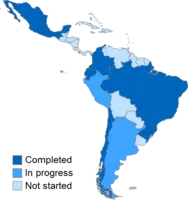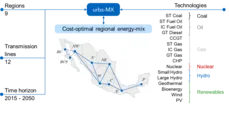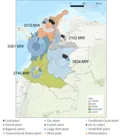Challenges and opportunities
Latin America and the Caribbean (LAC) is a region known for its abundance of natural resources. LAC’s climate conditions are excellent for the development of renewable energy projects: hydro, solar and on-shore wind potential are above the global average.
However, the installation of new renewable capacity is lagging behind. Identifying the barriers and opportunities in the economic, regulatory, technical and social dimensions is key to understand the current energy system and to derive pathways towards a sustainable, robust, resilient and coordinated regional energy system that can accelerate the development of the region.
Research focus
1. LCA energy database
We are currently working in a detailed open and transparent database of the energy sector of the LAC countries with all the necessary information for the characterization of their energy system taking into consideration the technical, economic, social and environmental aspects. This database will contain among other variables, the information of the current generation matrix, time series for renewable energy resources, energy demand for electricity, heating and cooling, fuel costs, current interactions with neighboring countries as well as protected areas, electrification requirements, climate change mitigation objectives and environmental impacts.
2. Country-level energy models of LAC countries
Even though there are many common factors, the energy system of the countries in the LAC region are quite heterogeneous. For instance, the abundant renewable energy resources are not evenly distributed throughout the whole region. Additionally, the energy needs differ also substantially. Therefore, detailed national energy models, based on the LAC energy database, are also being developed at the chair. So far, we have worked on national models for Argentina, Brazil, Chile, Colombia, Ecuador, Mexico, and Peru. Here, the integration of nationally determined climate change mitigation strategies (NDCs) consistent with a pathway towards low greenhouse gas emissions and climate-resilient development are a key element of the proposed country-level models. In this way, we can identify the strengths, weaknesses, challenges and opportunities of the energy systems of each country by the transparent and reproducible analysis of the current state and projections of the energy sector.
3. Integrated LAC energy system
Our ultimate goal is to develop an integrated model of the Latin American energy system. By including the national models and adding explicit interconnections between neighboring countries, we will be able to explore several long-term planning scenarios of interconnection and integration among the LAC countries. Such cooperation opportunities allow the efficient operation of the power systems and ensure the regional least-cost dispatch of energy as the energy matrix is diversified through the sustainable exploitation of renewable and non-renewable energy sources across the region. Consequently, we aim at a robust regional energy system that complies with the three pillars of sustainability (environment, society and economy) and that fosters the joint development of the region.



